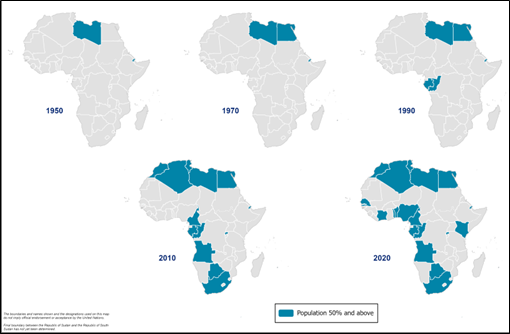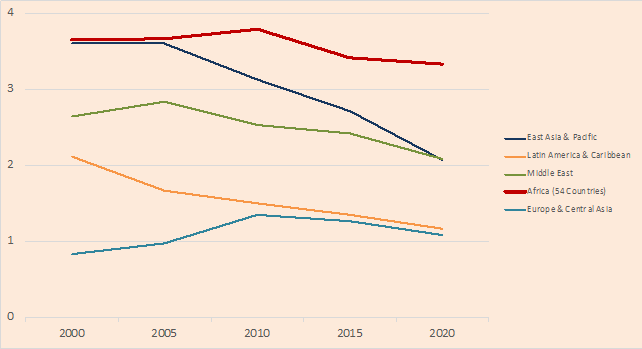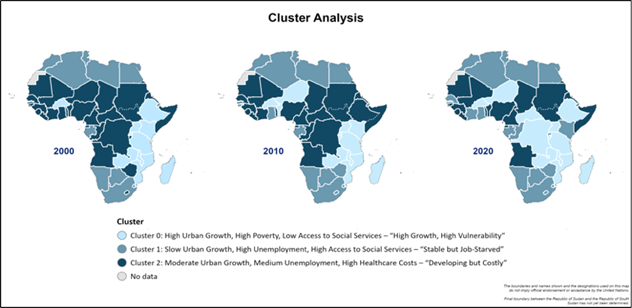In 2024, the UN Secretary-General declared, “Cities are on the front lines of shaping a world that is more prosperous, sustainable, and inclusive” (United Nations, 2024). Nowhere is this statement more resonant than in Africa, where urban landscapes are transforming at an unprecedented pace.
Over the past century, Africa has transformed from predominantly rural societies to the world’s fastest-urbanizing continent. This blog explores the dynamics of Africa’s urban population growth over the past two decades, providing a flavor of the socioeconomic implications and offering actionable recommendations to foster prosperous, sustainable, and inclusive urban future.
A Century of Dynamic Growth
Since 1900, Africa’s urban landscape has undergone a remarkable transformation. Initially, most Africans relied on farming, hunting, and gathering, with urban centers comprising a small fraction of the population (Bloom & Sachs, 1998). Urbanization accelerated after 1960, spurred by the independence of many African nations and driven by demographic, economic, social, political, environmental, and technological factors. Between 2000 and 2020, this trend intensified, with urban populations growing significantly across the continent. For instance, Nigeria’s urban population rose from 35% to 52%, Tanzania’s from 22% to 35%, and Zambia’s from 35% to 45% (World Bank, 2021). Since 2000, approximately five African countries per decade have crossed the 50% urbanization mark, meaning over half their populations live in urban areas, reflecting a profound shift toward urbanized societies. Africa emerged as the world’s fastest-urbanizing region, with a 3.5% annual urban growth rate, outpacing East Asia (3%), the Middle East (2.5%), and Latin America (1.5%) (see figure 2).
Figure 1. The evolution of population living in urban areas

Figure 2. Rate of urban population growth (2000-2020) (percentage)

Yet, this growth is uneven. From 2000 to 2020, Africa’s urbanization journey unfolded along three dynamic paths, each shaping the continent’s urban landscape in unique ways:
-
Steady Growth: Urban expansion held a consistent pace, laying the foundation for Africa’s evolving cityscapes.
-
Sharp Deceleration: A marked slowdown reflected major structural or policy shifts, reshaping the trajectory of urban growth.
-
Gradual Stabilization: Urbanization continued to rise but at a slower or near-constant rate, signaling a new phase of development.
Notably, 32 of Africa’s 54 countries experienced declining urban growth rates, while 22 nations sustained robust growth above 3.5%, home to 405 million urban dwellers.
Since 2010, Africa’s urban growth has stabilized at or above 3.5%, revealing a tapestry of diverse trends. These patterns—decline, growth, and stabilization—underscore the need for tailored policies to address regional differences and unlock urbanization’s potential for sustainable, inclusive development across the continent.
Urbanization and Development: A Complex Nexus
To understand the interplay between urbanization and development, ECA analyzed data on urban population growth, GDP per capita, poverty, infrastructure, and social services across 54 African countries from 2000 to 2020. A cluster analysis categorized countries into three groups based on urbanization speed and socioeconomic conditions (see figure 2):
-
Cluster 0: This cluster comprises countries characterized by high urban population growth rates, elevated poverty levels, and low access to social services.
-
Cluster 1: This cluster includes countries with slow urban population growth, high unemployment rates, but relatively high access to social services.
-
Cluster 2: This cluster consists of countries with moderate urban population growth, moderate unemployment, and limited access to social services.
Figure 2. Cluster Analysis (2000-2020)

The cluster analysis highlights a notable spatial divide among African countries, driven by similarities in economic development and urbanization rates. It reveals that rapid urbanization often coincides with weaker development outcomes. As depicted in Figure 2, countries with higher urban population growth rates tend to exhibit greater challenges in social service provision and higher poverty levels. This pattern is particularly evident in West, Central, and East Africa over the past two decades (2000–2020), where urban population growth has outpaced the continental average of 3.5% per year.
The association between rapid urbanization and development outcomes is further elucidated through correlation analysis. A new analysis conducted by ECA reveals a negative association between rapid urbanization (above 3.5%) and socioeconomic variables, such as poverty, employment, education, access to infrastructure, and telecommunication. The correlation analysis provides evidence that countries with high urban growth often face challenges in infrastructure access and economic development, with increased poverty and strained social services.
Africa’s Urbanization: final thoughts for shaping Sustainable Development
African urbanization is a dynamic and transformative process, marked by distinct demographic trends, widespread informal settlements, significant economic opportunities, regional variations, and deep interconnections with rural areas. The urgent need to invest in sustainable cities across the continent arises from these unique urban dynamics, their potential to drive economic growth, and the pressing need to address interconnected social, environmental, and infrastructural challenges. As the speed of urban population growth can leverage more costs than benefits for everyone, it becomes imperative putting key measure at the core of the urban. Sustainable urbanization and socioeconomic transformation need better targeting policies focussed on adapting to the different pattern of growth and fostering the social development.
To address Africa’s rapid urbanization, key strategies include:
-
Strengthen Rural Development: Invest in rural infrastructure, agriculture, and jobs to mitigate migration to cities. Enhance access to education, healthcare, and modern farming techniques to make rural areas viable, mitigating rapid urbanization and promoting equitable growth.
-
Decentralize Economic Opportunities: Develop secondary cities and regional hubs by incentivizing businesses to operate outside major urban centers. Invest in high-potential smaller cities and satellite hubs to distribute population growth and ease pressure on primary cities.
-
Enhance Local Governance: Empower local governments with fiscal autonomy (e.g., property taxes) and devolved powers to tailor policies like zoning and waste management. Promote participatory governance through community councils or town halls.
-
Boost Skills and Jobs: Equip people with relevant skills and create jobs to stabilize urban migration, foster economic growth, and reduce reliance on the informal sector.
-
Leverage Technology and Data: Use digital tools and data-driven insights to improve urban planning, optimize resources, and enhance service delivery, addressing urbanization challenges proactively.
-
Promote Regional Cooperation: Coordinate cross-border migration policies, shared infrastructure, and best practices to manage urbanization. The African Continental Free Trade Area (AfCFTA) can drive industrial growth and decentralize opportunities, reducing pressure on major cities.
The Road Ahead
Africa’s urban transformation is a defining moment in its history. The continent’s cities are not just growing—they’re redefining what’s possible for prosperity, sustainability, and inclusion. By learning from the past two decades and acting on evidence-based strategies, African cities can lead the charge in building a future that benefits all.
Reference:
-
Bloom, David .E. & Sachs, J (1998). Geography, Demography, and Economic Growth in Africa. Brookings Papers on Economic Activity 2: 207-295.
-
United Nations. (2024). Press release. https://press.un.org/en/2024/sgsm22394.doc.htm
-
World Bank. (2021). World development report 2021: Data for better lives. The World Bank. https://wdr2021.worldbank.org/
-
World Bank. (2025) Open Data. https://databank.worldbank.org/
By Atkeyelsh Persson, Giuseppe Tesoriere, and Thomas Sinmegn

![[Blog] Africa's urban boom: shaping a prosperous, sustainable, and inclusive future](https://uneca.org/sites/default/files/styles/slider_image/public/storyimages/shutterstock_2387455777_1920x640.jpg?itok=vyuBEm0y)